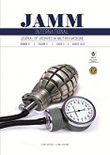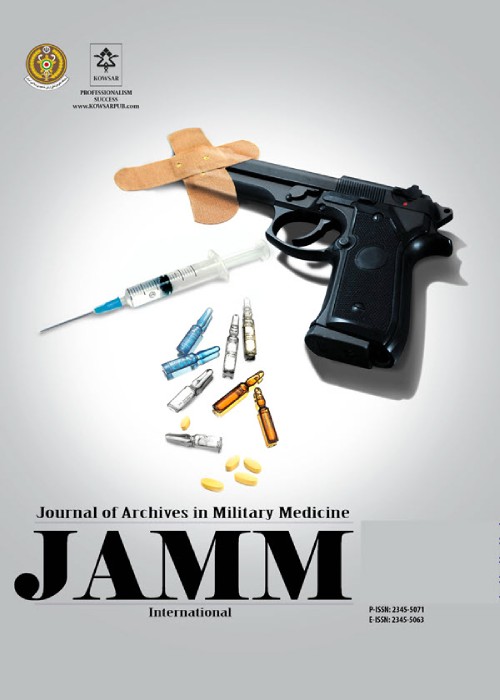فهرست مطالب

Journal of Archives in Military Medicine
Volume:3 Issue: 3, Aug 2015
- تاریخ انتشار: 1394/05/25
- تعداد عناوین: 7
-
Page 1Context: Soldiers are confronted with a variety of vector-borne threats and diseases during their missions in war areas. Among all threats, malaria holds an important place as a major health problem in tropical or hyperendemic areas. Malaria control in war areas has been deemed one of the most challenging goals of different armies throughout history..ObjectivesThis study intends to introduce the integrated vector management (IVM) for the control and prevention of malaria in war areas by employing an appropriate combination of environmental management techniques and other conventional methods of vector control..Data Sources: For this review article, appropriate online databases, including PubMed, Wiley, and ScienceDirect were searched up to November 10th, 2014, using MeSH and free texts. Only English texts comprising research papers, reviews, and reports were included..Study Selection: Forty-three papers were utilized in this review article. The selected studies were classified according to their relation to malaria, war areas, and vector-control methods..Data Extraction: Information from the obtained studies was reviewed only according to the year of the publication and topics..ResultsFifty-five articles, including case reports, research papers, and review studies, were found but only 43 publications met the inclusion criteria. The reviewed publications were categorized into five major groups, viz. transmission, symptoms and diagnosis, chemical control, biological control, and environmental management..ConclusionsThis review paper recognizes and supports the IVM as an efficient method for malaria prevention and control in war areas..Keywords: Malaria Vector Control, Malaria Prevention, War Areas
-
Page 3Context: The irritable bowel syndrome (IBS) is a symptom-based gastrointestinal (GI) disease with the presence of symptoms such as abdominal pain and abnormal intestinal activities. It is a frequent GI problem encountered by physicians. The purpose of this paper was to review and assess some of the current and emerging pharmacological therapies for this syndrome..Evidence Acquisition: In the present study, data on the IBS were principally collected via Google Scholar and PubMed, followed by articles in journals and libraries..ResultsThe pathophysiology of the IBS has yet to be fully elucidated. Global medical attempts, including pharmacological therapy and herbal remedies, aim at curing and/or subsiding pain, flatulence, diarrhea, and constipation..ConclusionsThere is a need for new drugs in the setting of pharmacological therapy for the IBS. A new medical approach should include both novel and traditional drugs in order to reach to a desirable outcome for patients and improve their quality of life..Keywords: Diagnosis, Irritable Bowel Syndrome, Physiopathology, Pharmacotherapy
-
Page 4BackgroundBased on the research evidence, the efficiency of resistance exercises depends on the changes in the hormones level to improve the muscle strength and mass..ObjectivesThis study aimed to investigate the effect of a short course blood flow restricted resistance training on serum cortisol and testosterone levels in young men..Patients andMethodsA total of 30 healthy young men (aged 19 - 24 years) were volunteered for this study. Subjects were randomly assigned into three groups: low-intensity blood flow restricted (LIBFR) (n = 15) resistance exercise group (3 sets of 15 repetitions at 20% of 1RM (one repetition maximum)), traditional high-intensity without blood flow restriction (HIWBFR) (n = 12) resistance exercise group (3 sets of 10 repetitions at 80% of 1RM), and a control group (n = 13). Both LIBFR and HIWBFR groups trained for front leg and squat exercises 3 days per week for 3 weeks. Fasting growth hormone cortisol and testosterone levels were measured in the morning before and after exercise sessions. Data were analyzed with paired t-test and One-way ANOVA at the significant level of P < 0.05..ResultsSerum cortisol level significantly increased after the exercise for both protocols compared to baseline (P < 0.05). After 3 weeks, serum cortisol level increased significantly in LIBFR and HIWBFR groups compared to control group (P < 0.001). At the end of the exercise protocols, serum testosterone level was higher in LIBFR group compared to HIWBFR group; however, this difference was not significant (P 0.49)..ConclusionsShort term blood flow restriction (BFR) exercise stimulates cortisol hormones production in young men. However, this program seems too short to express any difference in testosterone change. Generally, it can be concluded that low-intensity resistance training can increase short-term BFR catabolic-anabolic hormones in young men..Keywords: Resistance Training, Cortisol, Blood Flow Restriction, Testosteron
-
Page 5BackgroundMortality indices are among the most important health indicators in every country. On the other hand, mortality has an unequal distribution in different socioeconomic levels..ObjectivesWe sought to evaluate the association between economic inequality and infant, under-5-year-old, maternal, and crude mortality rates in the world..Patients andMethodsIn this ecological study, data on 196 countries were obtained from the World Bank to assess the relation between economic inequality and mortality in 2013. Per capita gross domestic product (GDP), gross national income (GNI), out-of-pocket index, and per capita health expenditure were extracted as economic variables. Data analysis was performed using STATA, version 12..ResultsThe results showed that poorer countries had higher rates of infant, under-5-year-old, and maternal mortality. Among the economic indicators, per capita health expenditure, per capita GDP, and GNI had an important role in creating disparities, whereas the out-of-pocket index had no impact..ConclusionsPer capita GDP, GNI, and per capita health expenditure played a significant role in creating disparities. Since per capita GDP and GNI are less variable, an increase in health expenditure can reduce inequality in mortality rates..Keywords: Socioeconomic Factors, Infant Mortality, Maternal Mortality, Child Mortality
-
Page 6BackgroundVirtual screening (VS), as a computational technique, is being used widely in drug discovery research. One of the widely used VS methods is based on the docking of every ligand structure in a specific macromolecule. Multiple popular VS tools do not provide a graphic user interface (GUI)..ObjectivesIn the present study, we have developed a VS software: IranVScreen, which is an easily operable tool for medicinal chemists and pharmacologists to carry out multiple practical virtual screening tasks..Materials And MethodsThe software was developed using Microsoft’s Visual Studio 2012 in visual basic and C++. It integrates Open Babel and Autodock Vina platforms. The software includes an easy to use Persian localized GUI. IranVScreen is composed of three application layers: application layer, class interface layer and software entity layer. Application layer consists of three functional nodes. The software entity layer includes the external tools..ResultsThe GUI provides the required data to other modules and displays the results to the user..ConclusionsThese results describe that IranVScreen provides a very intuitive all-in-one GUI to carry out multiple VS tasks in several mouse clicks with minimal requirement of skill. This software localized in Persian language surpasses the language barrier for novice users..Keywords: Software, Computational Intelligence, Mass Screening
-
Page 7BackgroundInappropriate use of antibiotics is one the most important challenges for health systems. In the hospital setting, intensive care unit (ICU) is a unique place in generating antibiotic-resistant pathogens. Irrational use of antibiotics is one of the main reasons of increasing the resistance of pathogens..ObjectivesIn this study, we aimed to evaluate antibiotics use pattern in ICUs of five hospitals in Tehran, Iran..Materials And MethodsThis observational cross-sectional research aimed to evaluate antibiotic use patterns in ICUs of five hospitals in Tehran, Iran. Retrospectively, data related to antibiotic consumption in ICUs of five Military General Hospitals were collected from 20 March 2011 to 20 March 2012. The Anatomical Therapeutic Chemical classification system and the Defined Daily Dose used to evaluate consumption of antibiotics and drug use 90% was determined for all ICUs antibiotic consumption. Data was analyzed by SPSS software version 16 using one way ANOVA and Tukey post hoc tests to compare antibiotic consumption in ICUs between different hospitals..ResultsAntibiotic use in ICU2 ward of hospital C was significantly higher than hospitals A, D, E and ICU-Open Heart (ICUOH) of hospital C (P value ≤ 0.001). Use of antibiotic in ICU1 ward of hospital C was also higher significantly compared to hospitals D, E and ICUOH of hospital C (P value ≤ 0.001). Drug use 90% profile of hospitals’ ICUs showed that Beta-lactams, Cephalosporin and Vancomycin were the most antibiotics used in these wards..ConclusionsUse of antibiotics was higher than expected in the studied ICU wards and the antibiotics use pattern was different from other countries. This problem should be addressed to correct the use pattern of antibiotics in ICUs. Implementation of antibiotic use and microbial resistance monitoring programs, continuous medical education for physicians and compilation of clinical practice guidelines and protocols could be effective in reduction of antibiotic use in hospitals..Keywords: Intensive Care Units, Antibiotics, Hospital


